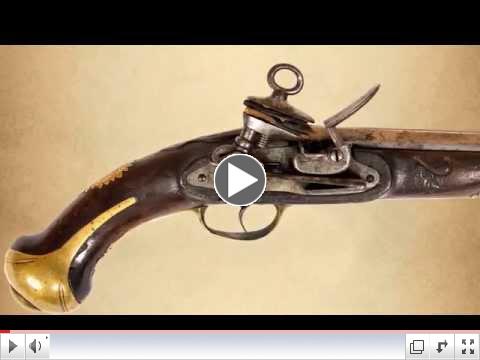|
The Alamo Messenger
|
February 2015
|
|
|
Remembering Through Education
|
|
|
|
Throughout the siege of the Alamo, William B. Travis wrote a series of letters seeking reinforcements for the besieged garrison. The most well known of these letters is the one he wrote on February 24th, which is commonly referred to simply as "The Travis Letter." Keep Reading |
By Express Night & Day
William Travis's letter on February 24, 1836 is perhaps the most recognizable document produced during the Texas Revolution. This 7th grade lesson plan traces the route the letter traveled after leaving the Alamo to teach about travel and communications in 19th century Texas.
|
|
Additional Primary Sources
|
Firearms of the Texas Frontier Exhibit Videos
|
 | | The Evolution of the Winchester: From Flintlock to Cartridge |
 | | 1873 Colt Single Action Army Revolver |
 | | Flintlock Pistol (Firearms of the Texas Frontier) |
|
|
 |
|
Greetings!
Greetings and welcome to the February 2015 edition of the Alamo Messenger. This month's issue explores the advance of the Mexican army a  s well as the beginning of the siege of the Alamo. February also marks the anniversary of Texas secession. Read all about the secession debate and the surrender of the Alamo by Union forces in our This Month in Texas History column.
|
|
|
Feature Article
Mexican Advance Historians have  chronicled the battles of Béxar, the Alamo, Coleto Creek, and San Jacinto mostly from the Texan perspective. While not exactly overlooked, the Mexican military viewpoint has been underrepresented. Just what was the Mexican Army's role in the Texas Revolution? Keep Reading chronicled the battles of Béxar, the Alamo, Coleto Creek, and San Jacinto mostly from the Texan perspective. While not exactly overlooked, the Mexican military viewpoint has been underrepresented. Just what was the Mexican Army's role in the Texas Revolution? Keep Reading
|
|
|
 |
Artifact of the Month
Mexican Dolores Calvary Helmet
This is an excellent example of a Mexican Army Cavalry helmet. This helmet has a leather body, horse hair crest, tricolored pompom and chin strap. The front of the helmet contains a brass plate with  | |
Click on Photo to Enlarge
|
the Mexican Eagle with a serpent in its mouth. The chin straps are scalloped brass and are held together by two brass lion heads. It measures 15 inches high by 10 inches wide. The Dolores Cavalry company served in the Texas Campaign under General Joaquin Ramirez y Sesma. Twenty five of the mounted lancers were requested by Antonio Lopez de Santa Anna to serve as his personal escort into Texas. During the siege and battle of the Alamo, the Dolores Cavalry's main duties were to pursue and stop any Alamo defenders that tried to flee. They were also present at the defeat of the Mexican Army at San Jacinto. This helmet was given to the Alamo as part of the Phil Collins Texana Collection. Photos and Text by Ernesto Rodriguez, III, Alamo Assistant Curator.
|
|
|
 |
|
Stories of Texas Women
Women of the Alamo One of the most enduring questions about the Battle of the Alamo is "Who was there?" Scholars have continuously debated the n umbers present on both the Texan and Mexican sides of the battle. Another group whose number remains contentious is the number of civilians inside the Alamo during the siege and battle. For this group the question is not only who was there, but also why were they there? Keep Reading umbers present on both the Texan and Mexican sides of the battle. Another group whose number remains contentious is the number of civilians inside the Alamo during the siege and battle. For this group the question is not only who was there, but also why were they there? Keep Reading |
|
|
Legend vs. Evidence
Battle of Alamo MythsThe story of the Alamo is known around the world. Like all legendary events, however, myths and misconceptions have sprung up that many people now take as fact. However, historical interpretation must be based on evidence. In the cases below, the evidence is either lacking or contradictory. Take a look at the following instances where evidence reveals some of the better known points of the Alamo story deserve updating.
|
|
|
 |
This Month in Texas History
February 16, 1861: Twiggs' Surrender
Following the election of Abraham Lincoln as President of the United States in 1860, the southern secessionist movement began in earnest. South Carolina became the first state to secede from the Union when it passed an  Ordinance of Secession on December 20, 1860. During January 1861, Mississippi, Florida, Alabama, Georgia and Louisiana followed South Carolina's lead and each approved their own Ordinance of Secession. Throughout Texas debate over whether or not the state should leave the Union was heated. Keep Reading Ordinance of Secession on December 20, 1860. During January 1861, Mississippi, Florida, Alabama, Georgia and Louisiana followed South Carolina's lead and each approved their own Ordinance of Secession. Throughout Texas debate over whether or not the state should leave the Union was heated. Keep Reading
|
|
|
Thank you for reading the February 2015 edition of the Alamo Messenger. Join us next month as we continue our month-by-month survey of the Texas Revolution. As always, we welcome your feedback on how we can continue to improve our newsletter and provide our subscribers with quality content.
Thank you, The Alamo Education Department Staff
|
|
|
Watch "The Alamo" at The Alamo 
FREE Outdoor Movie Event at the Alamo!
February 28, 2015
Seating limited to first 200 people
Gates Open at 6:00pm, Movie starts 6:30pm
Join us at 4:00pm in Alamo Hall for a discussion, "History vs. Hollywood"
Sponsored by Bolner's Fiesta Products
|
|
|
 | At the Alamo October 15th - April 15
|
|
|
|
|
|
|
|